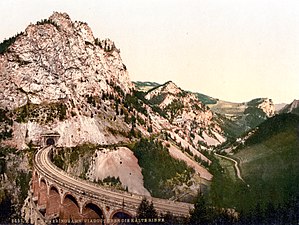Semmering Railway
| Semmeringbahn | |||
|---|---|---|---|

Semmering railway with
surrounding mountain scenery |
|||
| Operation | |||
| Owner | Austrian Federal Railways | ||
| Operator(s) | Austrian Federal Railways | ||
| Technical | |||
| Line length | 41 km (25.5 mi) | ||
| Track gauge | 1,435 mm (4 ft 8 1⁄2 in) | ||
| Minimum radius | 190 m (623 ft) | ||
| Electrification | 15 kV, 16⅔ Hz Overhead line | ||
| Maximum incline | 2.5 % | ||
|
|||
| Semmering Railway | |
|---|---|
| Name as inscribed on the World Heritage List | |
 |
|
| Location | Austria |
| Type | Cultural |
| Criteria | ii, iv |
| Reference | 785 |
| UNESCO region | Europe |
| Inscription history | |
| Inscription | 1998 (22nd Session) |
The Semmering railway (German: Semmeringbahn) in Austria, which starts at Gloggnitz and leads over the Semmering to Mürzzuschlag was the first mountain railway in Europe built with a standard gauge track. It is commonly referred to as the world's first true mountain railway, given the very difficult terrain and the considerable altitude difference that was mastered during its construction. It is still fully functional as a part of the Southern Railway which is operated by the Austrian Federal Railways.
The Semmering railway was constructed between 1848 and 1854 by some 20,000 workers under the project's designer and director Carl von Ghega born in Venice as Carlo Ghega in an Albanian family. The construction features 14 tunnels (among them the 1,431 m vertex tunnel), 16 viaducts (several two-story) and over 100 curved stone bridges as well as 11 small iron bridges. The stations and the buildings for the supervisors were often built directly from the waste material produced in the course of tunnel construction.
Across an overall track length of 41 km the Semmering railway overcomes an altitude difference of 460 m; on 60% of its length the gradient is 2.0-2.5% (equivalent to a 1-meter difference in altitude on a 40 m route distance) and 16% exhibit a curvature radius of only 190 m. This was an entirely new technical dimension of railway construction, and new instruments and methods of surveying had to be developed to handle the resulting challenges. Also, new technologies were employed for the Engerth locomotives because the types in general use at this time could not handle the extreme gradients and turning radii.
Even while being built the Semmering railway was perceived as an effort of "landscape gardening", i.e. it attempted a harmonious combination of technology and nature. The unique travel experience which the Semmering railway offered contributed significantly to the original opening of the Semmering region for tourism. Numerous hotels and mansions are witnesses of this epoch. This enormous upswing to the turn of the century and the revaluation of the region as a winter sports area in the first third of the 20th Century were interrupted first by World War I and then by the changed recreational needs of the population. Therefore, this unique culture landscape could be preserved with little change. A trip on the Semmering railway, which is in full use 160 years after its building, still impresses the traveller as a special experience by its varied landscape, the typical style of its mansions and the characteristic sequence of viaducts and tunnel constructions.
...
Wikipedia

